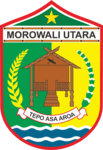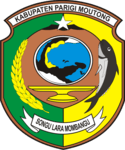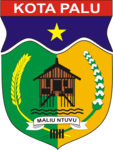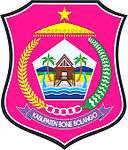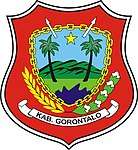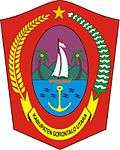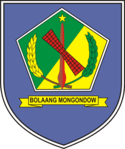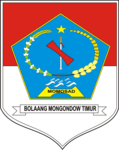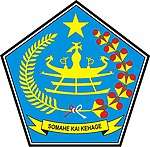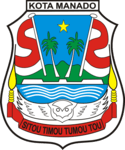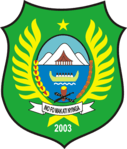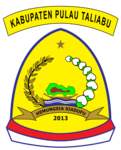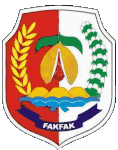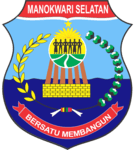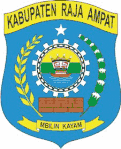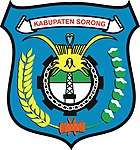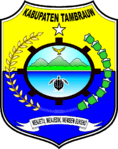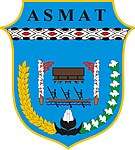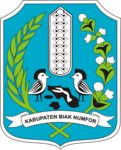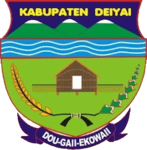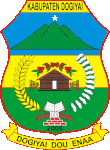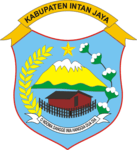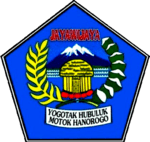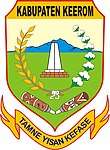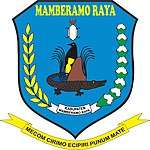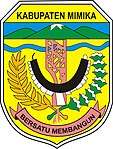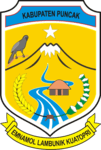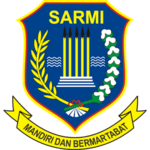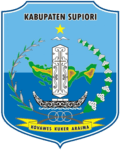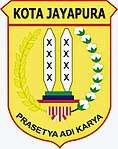Armorial of Indonesia
This is a list of emblems or seals used in Indonesia. Indonesia is divided into 34 provinces, and each province is divided into regencies (kabupaten) and cities (kota). There are 416 regencies and 98 cities. Each province, regency, and city has its own emblem.
Many of the emblems incorporate the rice and cotton (for prosperity and the 5th principle of Pancasila, a remnant from socialist heraldry popular during guided democracy era); symbols marking Pancasila in entirety; as well as symbols marking the date Indonesia declared its independence, 17 August 1945.
National
| Emblem | Name | Description |
|---|---|---|
 | National emblem of Indonesia | The emblem of Indonesia is Garuda, mythical bird from both Hindu and Buddhist mythology, invokes its pre-colonial Hindu and Buddhist kingdom in the archipelago, the ancestor of modern Indonesia. Unlike most depiction of Garuda with anthropomorphic features, this emblem are modeled after its national bird, the Javan hawk-eagle recognizable for its crest. Garuda symbolises strength and power, while the gold colour symbolises greatness and glory.
The feathers on the Garuda of the Indonesian coat-of-arms are arranged so that they invoke the date of 17 August 1945, the officially recognised Indonesian Day of Independence : 17 on each wing, 8 on the tail, 19 on below the shield, and 45 on the neck. The Garuda clutches a scroll on its talon bearing the National Motto "Bhinneka Tunggal Ika", an Old Javanese quote from 14th-century poem from Javanese Majapahit Empire, which means "Unity in Diversity". |
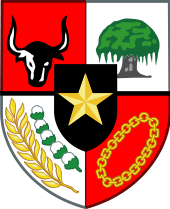 | Pancasila | The Garuda has shield with five emblems on its chest. The shield are coloured red and white similar to the National Flag and has thick black lines running horizontally on its center representing the equator which passes the Indonesian archipelago. Pancasila is a philosophical and foundational theory of Indonesian state which contains five principles each represented by the emblems:
|
Provincial
| No | Emblem | Name | Description |
|---|---|---|---|
| 1 |  | Emblem of Aceh | The emblem of Aceh is called Pancacita just like its motto, a sanskrit word which means "five hope" each represented by symbols inside the emblem: justice represented by balancing scale, heroism represented by rencong, prosperity represented by rice, cotton, and chimney, harmony represented by mosque dome, and religiosity represented by book and qalam. In addition white color represent purity, yellow represent glory, and green represent welfare.[1] |
| 2 | 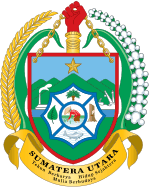 | Emblem of North Sumatra | A clenched fist wielding chain connected to a shield represent determination of the North Sumatran people, five pointed star, shield, and chain represent unity of the people to defend pancasila, factory, port, rubber tree, oil palm tree, tobacco leaf, and farmer represent the resources of the province, 17 cottons, 8-sided web, and 45 seeds of rice represent Indonesia independence day, Barisan Mountains in the background represent noble personality, sense of unity, and gotong royong within society. And lastly, the motto "Tekun Berkarya, Hidup Sejahtera, Mulia Berbudaya" is Indonesian word which means "work diligently, live prosperously, and noble culturally".[2] |
| 3 | 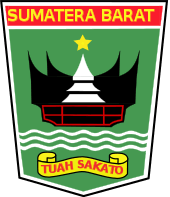 | Emblem of West Sumatra | The emblem contains mosque and Rumah Gadang, traditional homes with unique roof of the Minangkabau people, it represent the west sumatran people which firmly holds the traditional values and Islamic religion, the star represent the first Pancasila principle: Belief in One and Only God, the sea waves represent the dynamics of the society, and the motto "Tuah Sakato", which means "agreement to enforce the result of consensus decision-making to reach common goals". In addition, white represent purity, red represent courage, yellow represent greatness, black represent resilience and eternity, and green represent hope.[3] |
| 4 |  | Emblem of Riau | The emblem is a green shield with 45 links to represent the Indonesia year of independence, five wave represent pancasila, the ship on the center is called "Lancang Kuning", a legendary boat of the riau people, it symbolizes Riau peoples great history and its way of live as a people who depended on the sea, keris with serindit head symbolizes heroism and struggle. Lastly, rice and cotton represent prosperity.[4] |
| 5 | 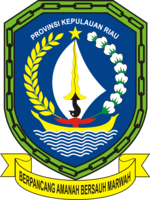 | Emblem of Riau Islands | The emblem consist of yellow five-pointed star represents first pancasila principle: Belief in One and Only God, chain surrounding the shield represents unity of the people, white-sailed yellow boat on the center symbolizes spirit of solidarity and determination of the people to accelerate development of the province, 24 seeds of rice and 9 cottons represent the formation of the province on 24 September 2002, keris with serindit head represent struggle to develop this maritime province to reach prosperity, red Tepak Sireh, a traditional Malay metal container to store betel, used for chewing and various traditional ceremony, it symbolize friendship, 7 waves symbolize 1 July 2004 when the province officially function, the motto "Berpancang Amanah, Bersauh Marwah" means Staked by Trust, Anchored by Dignity[5] |
| 6 |  | Emblem of Jambi | The emblem consist of five-sided base symbolize the Pancasilaic soul and spirit of the Jambi people, a mosque with 6 holes, 5 top foundations, 7 bottom foundations, and 1 keris represent the birth of the province on 6 January 1957, the mosque itself represent the religion of the Jambi people. Keris Siginjai, a legendary weapon from Jambi symbolize the struggle and heroism of Jambi people to defeat colonialism and tyranny. Cerana, a traditional container to hold betel symbolize the holiness of the God. Gong, a traditional musical instrument to represent spirit of democracy, four lines below the gong represent history of Jambi from kingdom times to its formation as province. And its motto: "Sepucuk Jambi, Sembilan Lurah" means that Jambi consist of nine traditional regions.[6] |
| 7 | 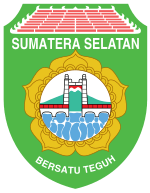 | Emblem of South Sumatra | On the center of the emblem is lotus with five petals symbolize the national ideology Pancasila, Ampera Bridge is an iconic building from South Sumatra, around the bridge is mountain and rivers represents the geography of South Sumatra, above the lotus is traditional South Sumatran roof with 17 points, 8 roof lines, and 45 roof tiles, it represent the Indonesian independence date. The motto "Bersatu Teguh" means "United (we) stands"[7] |
| 8 | 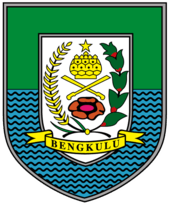 | Emblem of Bengkulu | Star represent the One and Only God, below the star is Cerana, a traditional metal container to hold betel represent tradition, Rudus, a traditional sword represent heroism, Rafflesia arnoldii represent the nature of Bengkulu, rice and coffee symbolize prosperity, 18 waves symbolize the birth date of Bengkulu province (18 November 1968)[8] |
| 9 | 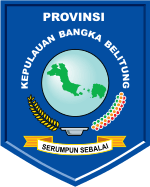 | Emblem of Bangka Belitung Islands | The emblem is five pointed shield symbolize the Pancasila, on the center is the map of Bangka Belitung represent the land, the people, the government, and the resources of the province. The map are inside a circle representing the unity of the people of Bangka Belitung to confront the globalized world, 27 seeds of rice symbolize the birth of the province based on the legislation number 27 year 2000, 31 peppers symbolize Bangka Belitung as the 31st province of Indonesia, both rice and pepper also symbolize prosperity, between the rice and pepper is tin ingot represents the natural resource of the country that support the economy of this region for more than 300 years. The emblem are coloured blue to represent the sea. The motto Serumpun Sebalai means People of Bangka Belitung is a community (serumpun) working together with a sense of kinship (sebalai) to achieve the goals.[9] |
| 10 | 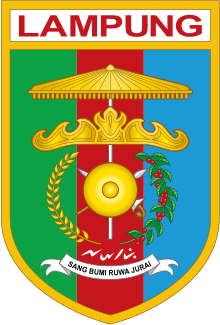 | Emblem of Lampung | The emblem consist of rice and pepper represents the resource of Lampung, golok and spear represents heroism, Gong symbolize democracy, Traditional crown called Siger symbolize culture and tradition, traditional umbrella represent protection. Lastly, the motto Sang Bumi Ruwai Jurai is Lampung language which literally means One Land, Two Peoples, can be interpreted as harmony between native Ulun Lampung and migrant from other part of Indonesia.[10] |
| 11 | 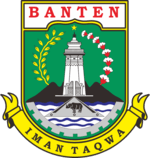 | Emblem of Banten | Below the text "BANTEN" is an outline of mosque dome symbolize religious culture of the people, star represents the first verse of Pancasila: Belief in One and Only God, tower of the Great Mosque of Banten symbolize great spirit with the guidance of the God, Gate of the Kaibon Palace below the tower represents Banten as a gate to global civilization and international trade, rice and cotton symbolize Banten as an agrarian province, the number of seed have significance of Indonesian Independence Day, black mountain in the background represents the land and resources, the one horned javan rhinoceros is the provincial animal and symbolize the persistence of the society to defend justice and protected by law, the rhino are standing on an airport runway represents the Soekarno–Hatta International Airport, half-gear below the mountain represents development and industry orientation, blue wave represent the sea, the motto "Iman Taqwa" is a concept in Islamic faith, written on yellow scroll represents unity.[11] |
| 12 | 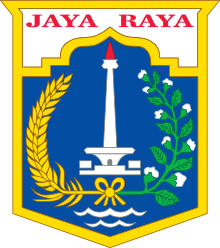 | Emblem of Special Capital Region of Jakarta | Designed by the then governor Henk Ngantung during his tenure. The emblem is five-pointed shield to symbolize Pancasila, the Indonesian ideology, with an outline of a gate and Indonesian National Monument to represent Jakarta as a special city, not only as the capital of Indonesia but as a city where Proclamation of Indonesian Independence happened. Rice and cotton are symbol of resources tied with golden rope symbolize unity, wave represent the sea, and the motto "Jaya Raya" which means "Glory and Greatness" written in red to symbolize heroism. The colour gold symbolize the holiness and greatness of Pancasila, white represent purity, yellow and green represent prosperity, and blue background represent the far-reaching sky.[12] |
| 13 | 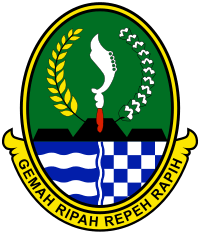 | Emblem of West Java | The emblem is egg-shaped shield used by past kingdom and the background is coloured green to represents the richness of its soil, on the center is kujang, a traditional weapon of the Sundanese people, the kujang have five holes on it to symbolize pancasila. There are 17 seeds of rice and 8 cottons represents the date of Indonesian independence on 17 August, below the kujang is black mountain represents the terrain of the province which made up of many mountains, below it are wavy lines to represents the river and seas and beside it is checkered pattern to represents the rice field and plantation, between the wavy and checkered pattern is white line to represents the dams and canals. The motto is Sundanese words "Gemah Ripah Repeh Rapih", the first two words means serene and prosperous, and the last two words means peaceful and harmonious.[13] |
| 14 | 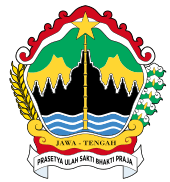 | Emblem of Central Java | The emblem base shape are described to be "Kundi Amerta", a ceremonial water jug, its five-pointed shape and the star symbolize Pancasila. Borobudur represents creativity, culture, and tradition, the twin mountains symbolize unity between local government and its people. The mountains, sea, and green background represents the natural geography of this province with its various resources as a livelihood of the Central Javan People. Below the star is bambu runcing or sharpened bamboo, a traditional weapon to symbolize heroism, rice and cotton symbolize prosperity, red and white pennant on top symbolize nationalism. The motto "Prasetya Ulah Sakti Bhakti Praja" is a sanskrit word which means A vow of devotion with all might to build the nation and the country.[14] |
| 15 | 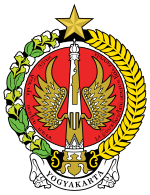 | Emblem of Special Region of Yogyakarta | The emblem are called golong-gilig because it has circle (golong) and cylinder (gilig), it represents the philosophy of life. It has pancasilaic meaning, the first principle "Belief in One and Only God" is represented by five-pointed golden star, the second principle "Humanity" is represented by winged central pole/monument (Saka guru), the third principle "Unity" is represented by red circle surrounded by white circle, the fourth principle "Democracy" represented by object below the central pole called "Ompak", it is a traditional carved stone foundation, in this case are carved with lotus pattern, and the fifth principle is "Social justice" represented by rice and cotton. The other meaning that can be found in this emblem is religion, education, and culture which is represented by star and jasmine below it with three sepals. Within the red circle is sentence written in Javanese script: "Rasa Suka Ngesti Pradja, Yogyakarta Terus Mandiri" which means "with a sense of optimism to build Yogyakarta that stand on its own" [15] |
| 16 | 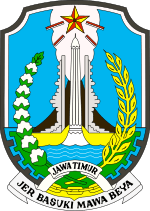 | Emblem of East Java | The emblem is a shield to symbolize peace and security, the star represents "Belief in One and Only God", the Heroes Monument symbolize heroism of the people during Battle of Surabaya, volcano represents the geography of the province, around the heroes monument is temple (candi) gates to symbolize struggle and patriotism, river, farmland, rice and cotton represent prosperity, in addition the rice and cotton have numerical significance that symbolize Indonesian date of Independence, the gear represents industry and sense of friendship to outsider, and the motto "Jer Basuki Mawa Beya" means "Sacrifice are needed to achieve goals".[16] |
| 17 | 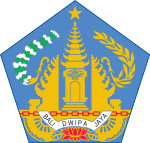 | Emblem of Bali | The emblem is pentagon to represents Pancasila, inside the pentagon is five-pointed star to represents "Belief in One and Only God". Margarana monument is symbolizing heroism of Bali people, the monument itself is a memorial for Battle of Margarana, the struggle of Balinese led by I Gusti Ngurah Rai to prevent the restoration of Dutch rule. Candi bentar, a traditional temple gate to symbolize religiousness. Chain represents unity and gotong royong, Balinese fans to represent culture and tradition, red lotus represents the throne of Shiva, rice and cotton represent prosperity and the motto "Bali Dwipa Jaya" means Glorious Bali Island, in addition the color blue represents solidarity, yellow represents glory, white represents purity, and red represents courage.[17] |
| 18 | 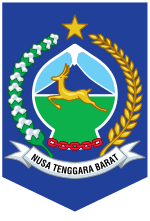 | Emblem of West Nusa Tenggara | The emblem is a shield to represents heroism and culture, inside the shield is star to represents Pancasila, Chain represent unity, rice and cotton represent prosperity, volcano represents Mount Rinjani, Dome shape represent religiousness, inside the dome is Javan rusa, the provincial animal. In addition, the color blue means loyalty, green means prosperity, white means purity, yellow means glory, black represent immortality, and red means courage to defend justice and truth.[18] |
| 19 | 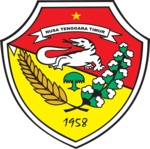 | Emblem of East Nusa Tenggara | The emblem is red-yellow coloured shield, inside the shield is a star to symbolize "Belief in One and Only God", Komodo dragon, the provincial animal symbolize the natural richness of the province, rice and cotton represent prosperity, spear represents glory and greatness, banyan tree represents unity, and the text "1958" is the birth year of this province.[19] |
| 20 |  | Emblem of West Kalimantan | The emblem base is a five-pointed shield to represent pancasila, the shield are coloured light green to represent fertility of the land. Inside the shield base is traditional Dayak shield, mandau, and keris to represent culture and tradition, each of them coloured white to represent holiness and purity. Straight white line on the center is symbolizing the equator which crossed the province. Rice and cotton represents prosperity. There are 17 cottons, 8 flames, and 45 rice seeds to represent Indonesia date of Independence. The rice and cotton are tied white four-pointed ribbon to represent "Catur Karsa" or four principles: sincerity, honesty, gotong royong, and kinship. The motto "Akcaya" is an Old Javanese word which means "Will never perish" written on a white three-fold scroll to represent three foundations of national revolution or universal ambition of Indonesian nations: Unity of Indonesian from Sabang to Merauke, spiritual and material justice and prosperity to society, and strengthen the relationship between all nations and states.[20] |
| 21 | 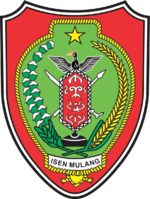 | Emblem of Central Kalimantan | The emblem consists of sacred green jar (Balanga) to represents the potential resources of the province, the jar is surrounded by yellow rope made out of plant roots called "Tali Tengang", this rope is commonly used by fisherman and also used in traditional ceremony, it represents unbreakable solidarity, the rope has 57 knots to represent the birth year of the province, inside the jar is traditional Dayaks shield or "Taliwang" and behind it is Mandau and Sipat or Blowgun to represents vigilance and endurance of the society to defend the country from inside and outside threat, the Taliwang are painted with pattern called "Haramaung Batulang, Pengadien Balikur Talawang" which means "Only tiger with muscle made out of wire, and bone made out of steel can stands against everything" it represents the struggle of the people to achieve justice and prosperous society. Rice and cotton represent prosperity, star represents Pancasila. Above the shield is Hornbill or "Enggang" the provincial animals to symbolize environmental protection, below the shield is musical instrument called "Galantung" which used to call people before announcing something or ceremonial purposes, it represents tradition and unity. Lastly, the motto "Isen Mulang" which means "Never Give Up" .[21] |
| 22 |  | Emblem of South Kalimantan | Shield represents vigilance and defense of the people, star represents the first principle of pancasila: "Belief in One and Only God", the house in the center is called Bubungan Tinggi, the traditional house of the Banjar people to symbolize culture. Diamond, rice, and rubber wood symbolize the resources of the province. The white ribbon represents the linkage of all aspect of life: food, clothing, culture, belief, etc. In addition, the color red represents courage, yellow means hope, green means fertility, white means purity, black means persistence. Lastly, the motto "Waja Sampai Kaputing" means "Keep Strong Until The End".[22] |
| 23 | 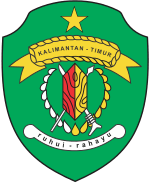 | Emblem of East Kalimantan | Shield represents defense of the people, star represents the pancasila, traditional Dayak weapons like shield called "Telabang", mandau, and blowgun represents readiness and competence. The weapons are surrounded by oil droplets and dammar resin to represent resources of the province, if the droplet and resins amount were added it becomes 17 which is the date of Indonesian independence. Above the shield is the name of the province surrounded 24 knots of rattan to represents the birth day of the province: 1 January 1957 (1+1+1+9+5+7=24), and below the shield is the motto: "Ruhui Rahayu" which means "Perfect harmony with the blessing from God", in addition the color green means fertility, gold means holiness and greatness, red means courage, white means purity, and black means sincerity.[23] |
| 24 | 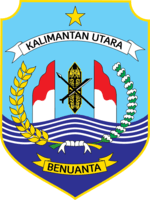 | Emblem of North Kalimantan | The emblem contain star represents the first principle of pancasila: "Belief in One and Only God", traditional Dayak, Bulungan, and Tidung weapons like shield, mandau, and spear represents harmony between various culture and readiness to confront challenge from inside and outside, rice and cotton represents prosperity, the blue wave represent the potential resources from the sea and its shape represents the dynamics of society, 4 white waves represents the four major river (Kayan, Sesayap, Sembakung, and Sebuku) of the province that connects the people of the hinterland to the coast and border, the red and white gate represent North Kalimantan as the frontier of Indonesia as it is bordering the neighboring Malaysia, and the motto "Benuanta" means "Our land for us to develop to achieve prosperous society". In addition the color blue means beauty, peace, and prestige, green means fertility and growth, yellow means holiness and greatness, red means courage and strength, white means purity and honesty, and black means sincerity and protection.[24] |
| 25 | 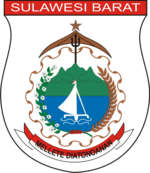 | Emblem of West Sulawesi | The emblem is a white jars that contain various object, in the center is circling patterns called "Meander Kalumpang Tegak", there are 14 outer and inner patterns, it represents the 14 historical Mandar kingdom within West Sulawesi that kept being united until today, its colored gold to symbolize prosperity, tranquility, and holiness. Within the meander pattern is the geography and resources of the province represented by mountains, farmland, and sea. On the sea lies traditional Mandarese boat called Sandeq facing forward to symbolize the people that keep moving forward, the boat colored white to represents genuine heart to change for the better. On the sea is 5 white waves to symbolize the five regency that exist during the province formation. Jasmine and rice tied with red silk represents prosperity, purity, beauty, openness, fragrancy, and manners. Above the mountain is "Doe Pakka" or Trident with each prongs represents courage, sharp mind, and knowledge, the trident is straight to represents strength and honesty, and colored black to represents humility. Above the trident is umbrella to represents protection, and above it is a star to symbolize pancasila and hopes. Lastly, the motto "Mellete Diatonganan" which means "Following the Truth" written on a red and white scroll that represents the country.[25] |
| 26 |  | Emblem of South Sulawesi | The emblem contain star represents the first principle of pancasila: "Belief in One and Only God". 17 seeds of rice, 8 seeds of cotton with 5 points on the fruit and 4 points of its leaves to symbolize date of Indonesian independence on 17 August 1945. Traditional dagger called Badik to represents heroism and vigilancy to defend the country. Mountain, village, and rice field to symbolize prosperity and fertility. Below the badik is Fort Somba Opu viewed from above to represents defense against imperialism and neocolonialism, within the fort is three emblems: Traditional pinisi boat represents the history of its people as seafarer that cross the ocean, it also symbolize persistence to continue the goals of Indonesian independence, gear and hoe represents the industry and agriculture, and coconut to represents the resources of the province. Lastly, the motto "Todo Puli" written in Lontara script means "Unshakable faith" [26] |
| 27 | 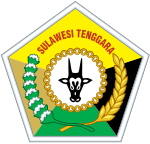 | Emblem of Southeast Sulawesi | The emblem is pentagon-shaped to symbolize Indonesian ideology Pancasila. Inside the emblem is rice and cotton to represents prosperity, unbroken chain made out of 27 links to represents unity and its birth date on 27 April. Within the chain is a head of endemic animal called Anoa to represents tenacity and agility. And lastly, the color white represents purity and the other color represents all the regency that exist during the province formation: Yellow represents Muna Regency which is rich in teak, brown represents Kolaka Regency which is rich in nickel, black represents Buton Regency which is rich in asphalt, and green represent fertile land of Kendari Regency, now renamed Konawe Regency to prevent confusion with Kendari City.[27] |
| 28 | 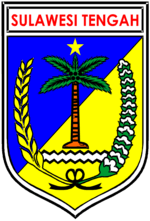 | Emblem of Central Sulawesi | The emblem are shaped like heart to symbolize the emblem meaning are derived from the heart of the people itself. The central part of the emblem is coconut tree which symbolize the resources because all parts of coconut tree are useful to human, it also represents sacrifice to achieve goals, tranquility, and persistence. The coconut tree has five leaves and five fruit to represent Pancasila, above it is a star to represents its first principle: "Belief in One and Only God". Waves represent the maritime culture of the province. Rice and cotton represents prosperity, it also have numerical significance to represents the province's birth date on 13 April 1964. In addition, the color blue represents loyalty and hope, yellow represents wealth and glory, green represents fertility, brown represents tranquility, and red represents courage.[28] |
| 29 | 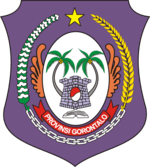 | Emblem of Gorontalo | The emblem to some extent was inspired by its namesake capital Gorontalo City. The emblem is colored purple which is one of traditional color in Gorontalo. Within the emblem is five-pointed star that represents Pancasila and rice and cotton that represents prosperity. In the center is white maleo egg and wings, the endemic bird that can be found all over Sulawesi, it represents hope like a bird that soar in the sky. Within the egg are coconut trees that represents its economy, Otanaha Fortress and book represent traditional proverb: "Adat bersendikan sara', sara' bersendikan kitabullah", which means traditional laws are based on religious laws, and religious laws are based on the Quran. Below the egg is the name of the province on red scroll and chain to represents unity.[29][30] |
| 30 | 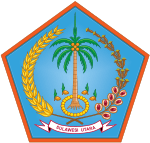 | Emblem of North Sulawesi | The emblem are pentagon shaped to symbolize Indonesia ideology Pancasila. Within the emblem are 45 seeds of rice on the left, 8 nutmegs and 17 cloves on the right, all of them symbolize the Indonesian Independence proclamation on 17 August 1945. On the center is 23 corn seeds encircling a coconut tree with 9 leaves, 6 roots, and 4 seeds just outside the corn circle, it represents the birth of the province on 23 September 1964. The corns, coconut, nutmegs, cloves, and rice all represents the resources of the province. In addition the various color on the emblem represents fertility, loyalty, glory, courage, persistence, and tranquility.[31] |
| 31 |  | Emblem of Maluku | The emblem is called "SIWALIMA" just like its motto, it's the philosophy of the Moluccans to unite the different groups to achieve prosperity. Within the emblem is sago palm leaves, sago is the staple food of Moluccans, and coconut leaves both to represents resources and life. On the center are spear to symbolize heroism, pearl to represents marine resources. Mountain, nutmeg, and cloves to symbolize the land and forest resources, sea and boat to represents everlasting unity. There are 17 coconut leaflets, 8 pearls, and 45 sago leaves, all of them represents the Indonesian date of Independence on 17 August 1945.[32] |
| 32 | 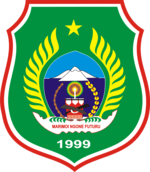 | Emblem of North Maluku | The emblem consist of various objects, the palm leaves, cloves, and nutmeg represents prosperity. Star represents the first principle of Pancasila: Belief in One and Only God. Mountain represents the land and its resources, sea and boats with radiant star represents unity. Traditional shield called Salawaku crossed with Parang blade represents heroism. The number 1999 represents the birth year of the province. And lastly, the motto: Marimoi Ngone Futuru which means United we stand.[33] |
| 33 | 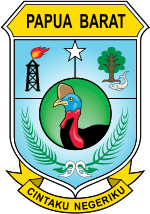 | Emblem of West Papua | The emblem is a five-pointed blue shield to represents Pancasila with its five principles that will protect the people. Within the shield is a white star to represents first principle of Pancasila: Belief in One and Only God. The shield is divided into three blue regions that symbolize the element of West Papua: Religion, Government, and People/Tradition, each of them work together to achieve common goals. The first region are depiction of gas flare found in oil plants to represents its mineral and petroleum resources, the second region depict a tree and a fish to symbolize the land and marine resources, the third region depict sago palm leaves with 12 leaflets on the right and 10 leaflets on the left, tied together with two karerin carvings of the Biak people both depicting number 9, it symbolizes the birth of the province on 12 October 1999. On the center of the shield is green circle with cassowary head to symbolize the province location as the "head and neck" part of the New Guinea island, it also represents courage, strength, persistence, and unity to achieve common goals. Lastly, the motto: Cintaku Negeriku is an Indonesian word which means My Love, My Country.[34] |
| 34 | 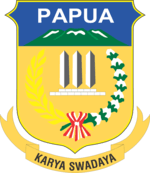 | Emblem of Papua | The emblem is five-pointed shield to represents defense and the Indonesian ideology Pancasila. The base colour of this emblem is gold represents glory and wealth of the land, blue represents marine resources, and the yellow border represents confidence to achieve all goals. On the center of the emblem is three monuments that stands on 6 upper foundation and 9 lower foundation, it represents the success of Operation Trikora and "PEPERA" or Act of Free Choice to unite Western New Guinea with Indonesia in 1969, the color white and black represents peace and purity. 17 seeds of rice and 8 cottons tied by red ribbon knots with 4 loops and 5 ends symbolize unity of the nations and country with the spirit of Proclamation of Indonesian Independence on 17 August 1945 to achieve just and prosperous society. Three mountains on the background represents the geography of the province, the colour green represents fertility of the Papuan island. Lastly, the motto Karya Swadaya means Work with one's own might.[35] |
Regencies and cities
Aceh







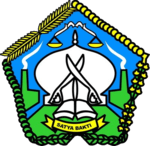





Bireuen Regency 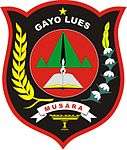
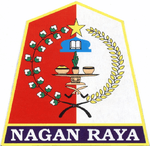



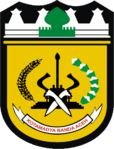




North Sumatra


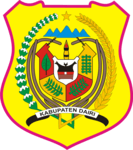

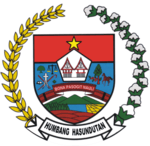
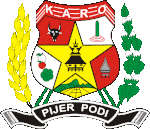
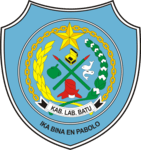
Labuhanbatu Regency 





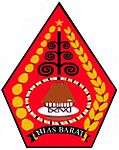
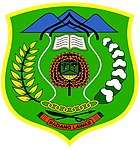

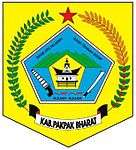






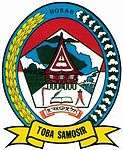
Toba Samosir Regency 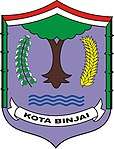



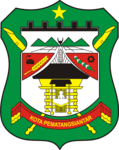


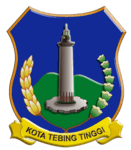
West Sumatra


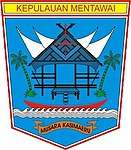

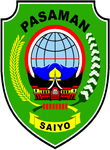


South Pesisir Regency 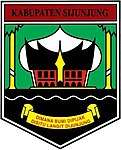



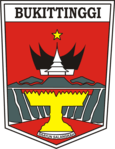
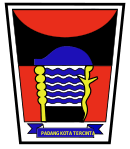
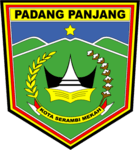




Riau

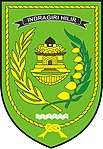
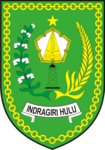


Meranti Islands Regency 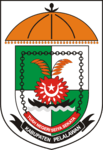



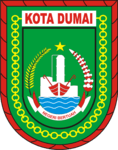
Lampung




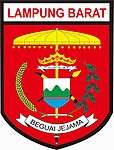

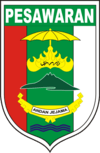
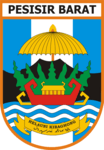





 City of Bandar Lampung
City of Bandar Lampung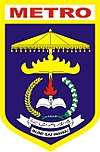
Central Java


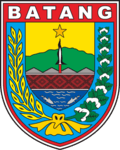
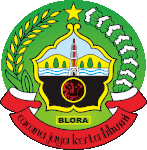

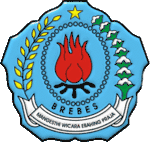
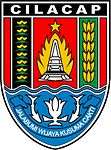

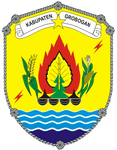


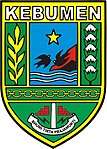

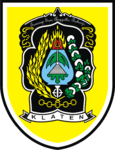




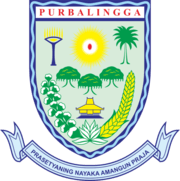



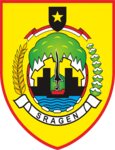


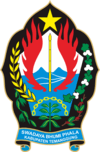
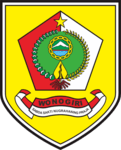





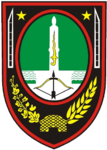

Tegal City
East Kalimantan
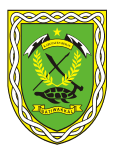




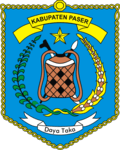
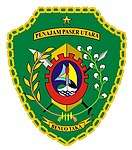
North Penajam Paser Regency 

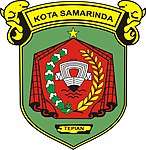
Maluku
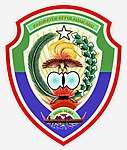







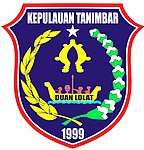

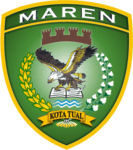
Tual City
Historical
National
 Coat of arms of East Indies (Indonesia) during VOC rule (1602–1799)
Coat of arms of East Indies (Indonesia) during VOC rule (1602–1799)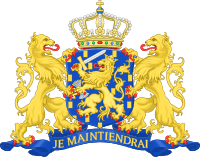 Coat of arms of Dutch East Indies (1800–1949)
Coat of arms of Dutch East Indies (1800–1949) Coat of arms of United States of Indonesia (1949–1950)
Coat of arms of United States of Indonesia (1949–1950)
Kingdom and Sultanate
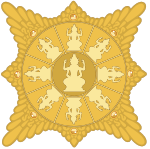 The Surya Majapahit, the emblem of the Majapahit Empire (1293–1527). The empire was dissolved in 1527 after being defeated by the Demak Sultanate.
The Surya Majapahit, the emblem of the Majapahit Empire (1293–1527). The empire was dissolved in 1527 after being defeated by the Demak Sultanate.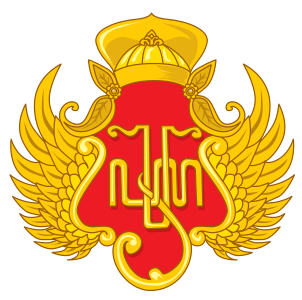 Emblem of Yogyakarta Sultanate (since 1755), the only monarchy with political power in Indonesia.
Emblem of Yogyakarta Sultanate (since 1755), the only monarchy with political power in Indonesia. Emblem of Surakarta Sunanate (since 1745). Its political power was taken by the government in 1946 and the territory merged into Central Java. But it still exists as a protector of Javanese culture
Emblem of Surakarta Sunanate (since 1745). Its political power was taken by the government in 1946 and the territory merged into Central Java. But it still exists as a protector of Javanese culture Emblem of the Riau-Lingga Sultanate (1824-1911). The sultanate was occupied, then abolished by the Dutch in 1911 and its territory were directly annexed into the Dutch East Indies.
Emblem of the Riau-Lingga Sultanate (1824-1911). The sultanate was occupied, then abolished by the Dutch in 1911 and its territory were directly annexed into the Dutch East Indies. Emblem of the Deli Sultanate (1632-1946). Its political power was taken by the government in 1946 and the territory merged into North Sumatra.
Emblem of the Deli Sultanate (1632-1946). Its political power was taken by the government in 1946 and the territory merged into North Sumatra..svg.png) Emblem of the Pontianak Sultanate (1771-1950). Its political power was taken by the government in 1959 and the territory merged into West Kalimantan.
Emblem of the Pontianak Sultanate (1771-1950). Its political power was taken by the government in 1959 and the territory merged into West Kalimantan. Emblem of the Banten Sultanate (1527–1813). The sultanate was defeated and abolished by the Dutch authority in 1813 while its remaining territory was annexed into the Dutch East Indies.
Emblem of the Banten Sultanate (1527–1813). The sultanate was defeated and abolished by the Dutch authority in 1813 while its remaining territory was annexed into the Dutch East Indies. Emblem of the Pagaruyung Kingdom (1347–1833). The kingdom was defeated and abolished by the Dutch in 1933 after the Padri War while its remaining territory was annexed into the Dutch East Indies.
Emblem of the Pagaruyung Kingdom (1347–1833). The kingdom was defeated and abolished by the Dutch in 1933 after the Padri War while its remaining territory was annexed into the Dutch East Indies.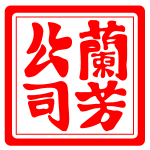 Emblem of the Lanfang Republic (1777–1884), a tributary state of the Qing Dynasty established in West Kalimantan, which was then occupied and dissolved by the Dutch in 1884.
Emblem of the Lanfang Republic (1777–1884), a tributary state of the Qing Dynasty established in West Kalimantan, which was then occupied and dissolved by the Dutch in 1884.
Subdivision
 Emblem of the former province of East Timor (1976-1999), now the independent state of East Timor
Emblem of the former province of East Timor (1976-1999), now the independent state of East Timor.svg.png) Coat of Arms of Surabaya during Dutch colonization.
Coat of Arms of Surabaya during Dutch colonization..svg.png) Coat of Arms of Bandung during Dutch colonization.
Coat of Arms of Bandung during Dutch colonization..svg.png) Coat of Arms of Buitenzorg during Dutch colonization, now called Bogor.
Coat of Arms of Buitenzorg during Dutch colonization, now called Bogor..svg.png)
.svg.png) Coat of Arms of Garut during Dutch colonization.
Coat of Arms of Garut during Dutch colonization..svg.png) Coat of Arms of Semarang during Dutch colonization.
Coat of Arms of Semarang during Dutch colonization..svg.png) Coat of Arms of Cirebon during Dutch colonization.
Coat of Arms of Cirebon during Dutch colonization..svg.png) Coat of Arms of Pekalongan during Dutch colonization.
Coat of Arms of Pekalongan during Dutch colonization..svg.png) Coat of Arms of Magelang during Dutch colonization.
Coat of Arms of Magelang during Dutch colonization..svg.png) Coat of Arms of Malang during Dutch colonization.
Coat of Arms of Malang during Dutch colonization..svg.png) Coat of Arms of Makassar during Dutch colonization.
Coat of Arms of Makassar during Dutch colonization..svg.png) Coat of Arms of Padang during Dutch colonization.
Coat of Arms of Padang during Dutch colonization..svg.png) Coat of Arms of Lampung during Dutch colonization.
Coat of Arms of Lampung during Dutch colonization..svg.png) Coat of Arms of Medan during Dutch colonization.
Coat of Arms of Medan during Dutch colonization..svg.png) Coat of Arms of Palembang during Dutch colonization.
Coat of Arms of Palembang during Dutch colonization..svg.png) Coat of Arms of Ambon during Dutch colonization.
Coat of Arms of Ambon during Dutch colonization. Emblem of the former Pontianak Regency (1963-2014). To prevent confusion with Pontianak City this regency was renamed to Mempawah Regency.[36]
Emblem of the former Pontianak Regency (1963-2014). To prevent confusion with Pontianak City this regency was renamed to Mempawah Regency.[36]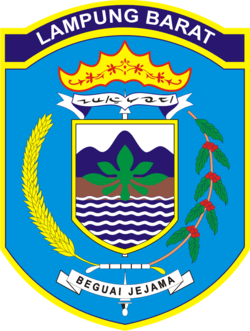 Former emblem of West Lampung Regency, with the creation of West Pesisir Regency from its territory, this logo was deemed not reflecting the current reality and replaced in 2015.[37]
Former emblem of West Lampung Regency, with the creation of West Pesisir Regency from its territory, this logo was deemed not reflecting the current reality and replaced in 2015.[37]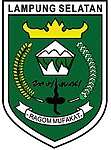 Former emblem of South Lampung Regency (1981-2011), this logo was deemed not reflecting the current reality and replaced in 2011.[38]
Former emblem of South Lampung Regency (1981-2011), this logo was deemed not reflecting the current reality and replaced in 2011.[38] Former emblem of Kendal Regency (1967-2011) replaced because it deemed not reflecting the current reality.[39]
Former emblem of Kendal Regency (1967-2011) replaced because it deemed not reflecting the current reality.[39] Former emblem of Pekalongan City used from 2014, deemed too abstract and after negative response the logo was reverted in 2017 to the one used since 1958.[40]
Former emblem of Pekalongan City used from 2014, deemed too abstract and after negative response the logo was reverted in 2017 to the one used since 1958.[40] First emblem of Southeast Minahasa Regency (2007-2010).[41]
First emblem of Southeast Minahasa Regency (2007-2010).[41] Second emblem of Southeast Minahasa Regency (2010-2014). This logo was negatively received because of lack of "Manguni" (Owl), faunal identity used by Minahasan people.[42]
Second emblem of Southeast Minahasa Regency (2010-2014). This logo was negatively received because of lack of "Manguni" (Owl), faunal identity used by Minahasan people.[42]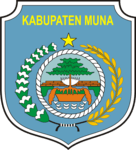 Former emblem of Muna Regency (2002-2012). With the creation of new West Muna Regency and North Buton Regency this logo was deemed not reflecting the current reality and replaced.[43]
Former emblem of Muna Regency (2002-2012). With the creation of new West Muna Regency and North Buton Regency this logo was deemed not reflecting the current reality and replaced.[43] Former emblem of Pasaman Regency (1981-2012). With the creation of new West Pasaman Regency from its territory this logo was deemed not reflecting the current reality and replaced.[44]
Former emblem of Pasaman Regency (1981-2012). With the creation of new West Pasaman Regency from its territory this logo was deemed not reflecting the current reality and replaced.[44]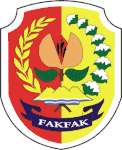 Former emblem of Fakfak Regency (1975-2008). By the suggestion of traditional leaders, the nutmeg fruit are reversed.[45]
Former emblem of Fakfak Regency (1975-2008). By the suggestion of traditional leaders, the nutmeg fruit are reversed.[45] Former emblem of Jayawijaya Regency.
Former emblem of Jayawijaya Regency. Former emblem of Buru Regency.
Former emblem of Buru Regency. Former emblem of Pangkal Pinang City
Former emblem of Pangkal Pinang City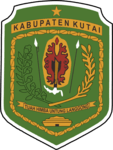 Emblem of Kutai Regency, now called Kutai Kartanegara Regency and has a new logo
Emblem of Kutai Regency, now called Kutai Kartanegara Regency and has a new logo Emblem of former Tanjung Jabung Regency, now split into West Tanjung Jabung Regency and East Tanjung Jabung Regency since 1999.[46]
Emblem of former Tanjung Jabung Regency, now split into West Tanjung Jabung Regency and East Tanjung Jabung Regency since 1999.[46] Former emblem of Central Lampung Regency
Former emblem of Central Lampung Regency Former emblem of Bandar Lampung
Former emblem of Bandar Lampung Emblem of Tanimbar Islands Regency used until 2019, this regency was formerly known as Western Southeast Maluku Regency.
Emblem of Tanimbar Islands Regency used until 2019, this regency was formerly known as Western Southeast Maluku Regency. Former logo of Penukal Abab Lematang Ilir Regency (2012-2016), rice and cotton not yet added.[47]
Former logo of Penukal Abab Lematang Ilir Regency (2012-2016), rice and cotton not yet added.[47]
References
- "Diskominfo dan Sandi Aceh - Arti Lambang Provinsi Aceh". diskominfo.acehprov.go.id.
- "Pemerintah Provinsi Sumatera Utara - Identitas Provinsi Sumatera Utara". www.sumutprov.go.id.
- "Arti Lambang Tuah Sakato". www.sumbarprov.go.id.
- "Pemerintah Provinsi Riau". www.riau.go.id.
- "Portal Kepriprov". www.kepriprov.go.id.
- "Pemerintah Provinsi Jambi - Profil Lambang Daerah". www.jambiprov.go.id.
- "Lambang Sumatera Selatan". sumselprov.go.id.
- "PEMERINTAH PROVINSI BENGKULU". bengkuluprov.go.id.
- "Pemerintah Provinsi Babel - Lambang Daerah dan Artinya". www.bantenprov.go.id.
- "Pemerintah Provinsi Lampung". www.lampungprov.go.id.
- "Pemerintah Provinsi Banten - Arti Lambang". www.bantenprov.go.id.
- "JAYA RAYA, LAMBANG JAKARTA". www.jakarta.go.id.
- "Lambang dan Motto Jawa Barat". www.jabarprov.go.id.
- "Pemerintah Provinsi Jawa Tengah". www.jatengprov.go.id.
- "LAMBANG DAERAH DAERAH ISTIMEWA YOGYAKARTA". www.jogjaprov.go.id.
- "Lambang Jawa Timur". www.jatimprov.go.id.
- "DISTANTP Bali - Selayang Pandang". distantp.baliprov.go.id.
- "Pemerintah Provinsi NTB - Makna Lambang Daerah". www.ntbprov.go.id.
- "Pemerintah Provinsi NTT - Arti Lambang Daerah Provinsi NTT". www.nttprov.go.id/ntt.
- "Peraturan Daerah Tingkat Ke-I Kalimantan Barat No.4 Tahun 1964" (PDF). jdih.kalbarprov.go.id.
- "Peraturan Daerah I Kalimantan Tengah No.5 Tahun 1985" (PDF). jdih.kalteng.go.id.
- "Pemerintah Provinsi Kalimantan Selatan". www.kalselprov.go.id. Archived from the original on 2019-04-06. Retrieved 2020-06-20.
- "Pemerintah Provinsi Kalimantan Timur - Lambang". www.kaltimprov.go.id.
- "Peraturan Gubernur Kalimantan Utara Nomor 4 Tahun 2014". www.kaltaraprov.go.id.
- "Peraturan Daerah Sulawesi Barat Nomor 8 Tahun 2006" (PDF). jdih.setjen.kemendagri.go.id.
- "Peraturan Daerah Sulawesi Selatan Nomor 2 Tahun 1972". bappeda.sulselprov.go.id. Archived from the original on 2019-11-10. Retrieved 2020-06-20.
- "Pemerintah Provinsi Sulawesi Tenggara". www.sultraprov.go.id.
- "Pemerintah Provinsi Sulawesi Tengah - Arti Lambang". www.sultengprov.go.id.
- "Sosok Dibalik Logo Provinsi Gorontalo". www.gorontaloprov.go.id.
- "Arti Lambang Gorontalo Kota". www.gorontalokota.go.id.
- "Pemerintah Provinsi Sulawesi Utara - Arti Lambang". www.sulutprov.go.id. Archived from the original on 2017-11-03.
- "Pemerintah Provinsi Maluku - Arti Lambang". www.malukuprov.go.id.
- "Pemerintah Provinsi Maluku Utara". www.malutprov.go.id.
- "Pemerintah Provinsi Papua Barat". www.papuabaratprov.go.id. Archived from the original on 2010-06-02. Retrieved 2020-06-20.
- "Pemerintah Provinsi Papua - Arti Lambang Papua". www.papua.go.id.
- "Siap Umumkan Nama Baru Daerah". www.mempawahkab.go.id.
- "Logo Lampung Barat Yang Baru Resmi Dipakai". www.polpplampungbarat.com. Satpol PP Lampung Barat.
- "Peraturan Daerah Lampung Selatan No.23 tahun 2011 Tentang Bentuk, Warna dan Isi Lambang Daerah Kabupaten Lampung Selatan". www.lampungselatankab.go.id. Pemerintah Lampung Selatan.
- "Perda Kabupaten Kendal No. 21 Tahun 2011" (PDF). jdih.setjen.kemendagri.go.id.
- "Peraturan Daerah Kota Pekalongan No.3 Tahun 2017" (PDF). www.jdih.setjen.kemendagri.go.id.
- "Simbol Manguni Dominasi Lambang Baru Mitra". Tribun News.
- "Simbol Manguni Dominasi Lambang Baru Mitra". Tribun News.
- "Perda Kabupaten Muna No. 2 Tahun 2012" (PDF). jdih.setjen.kemendagri.go.id.
- "Perda Kabupaten Pasaman No. 4 Tahun 2012" (PDF). jdih.setjen.kemendagri.go.id.
- "Perubahan Atas Perda Kabupaten Daerah Tingkat II Fakfak Nomor 5 Tahun 1975". jdih.setjen.kemendagri.go.id.
- Profil Daerah Kabupaten dan Kota (1 ed.). Penerbit Kompas. 2001.
- "Lambang Kabupaten PALI Ditambah Padi dan Kapas". koransn.com.
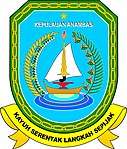
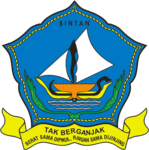
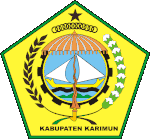
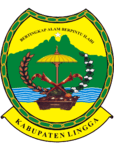
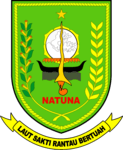

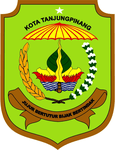
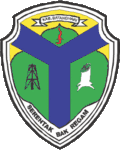
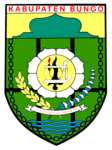

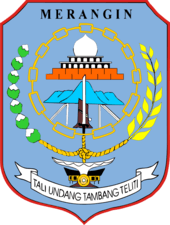
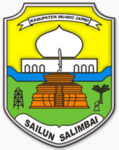
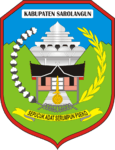
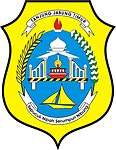


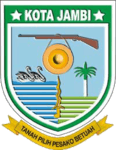

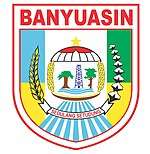
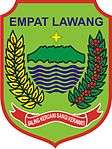

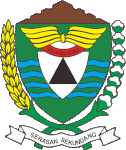

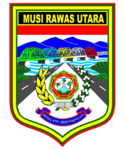

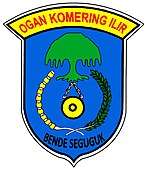

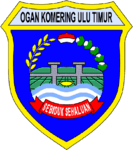

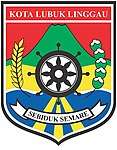
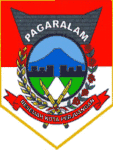
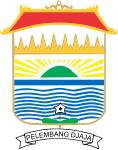


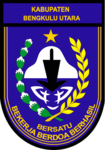
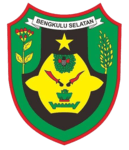
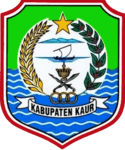

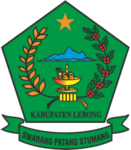


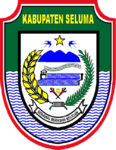
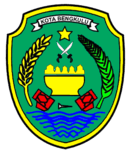

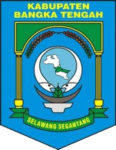
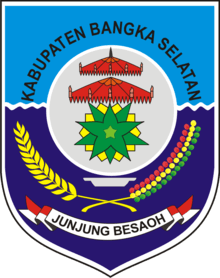

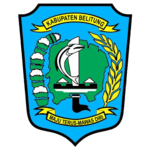

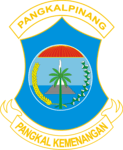
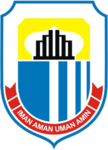





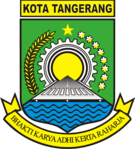




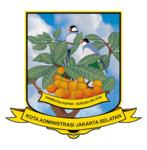
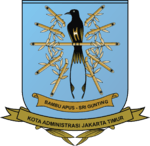




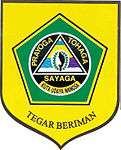



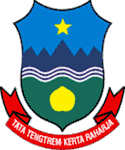
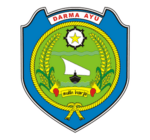



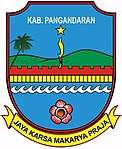
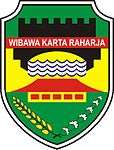


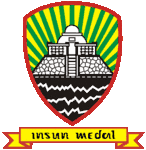
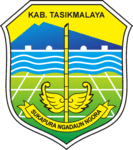


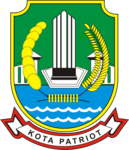


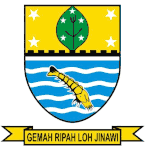

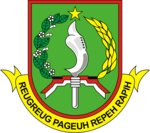

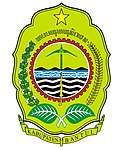


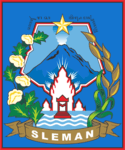
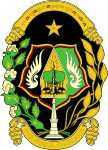
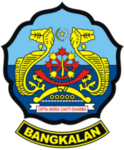



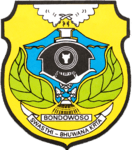
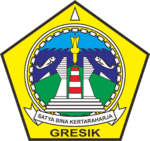

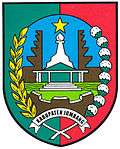

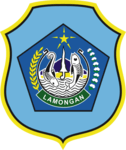
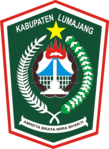






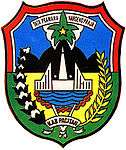

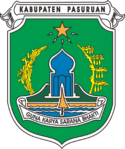
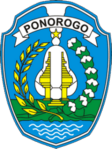





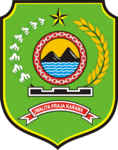

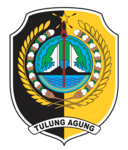
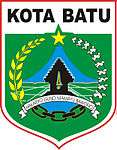
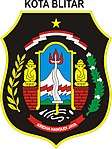

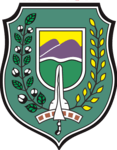
.svg.png)


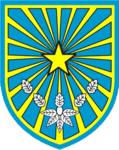
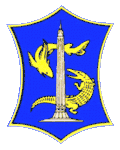
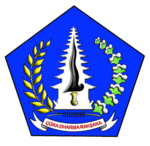
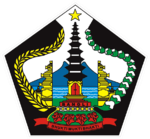
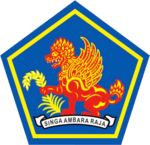

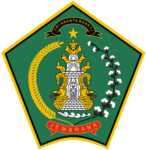


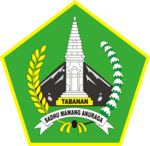
.png)












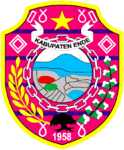

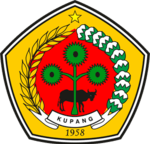



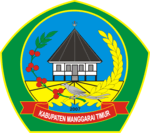

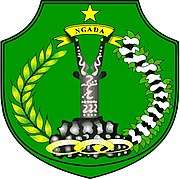






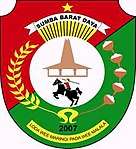
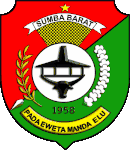


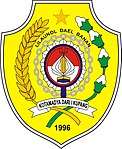
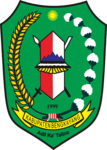









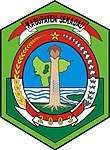

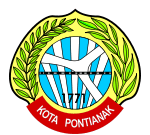


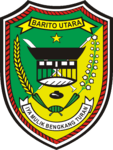
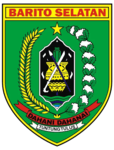

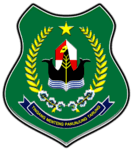
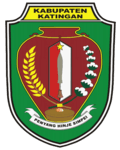


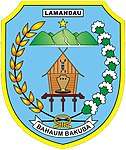
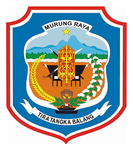

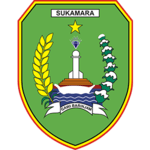









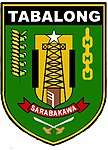




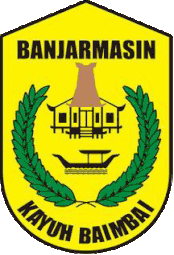
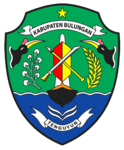
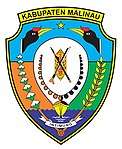







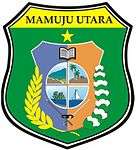





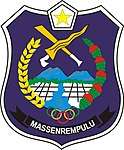

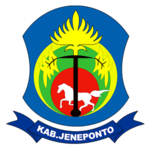


.png)



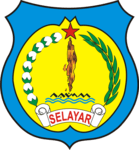


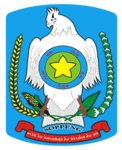

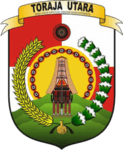
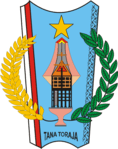

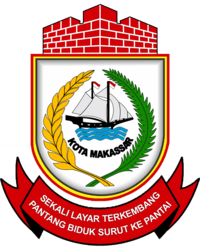

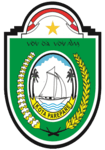
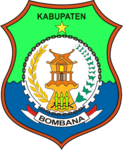
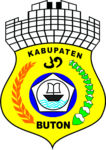

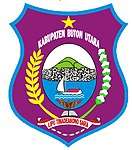
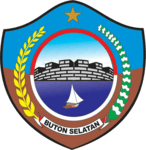

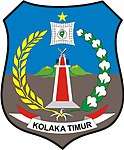

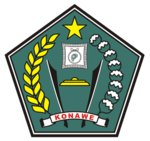
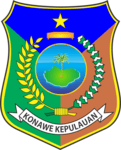


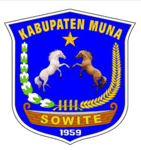
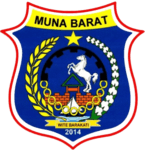
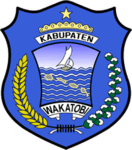
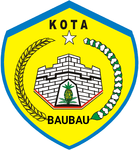
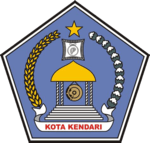




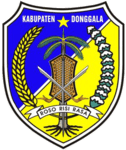
.png)
